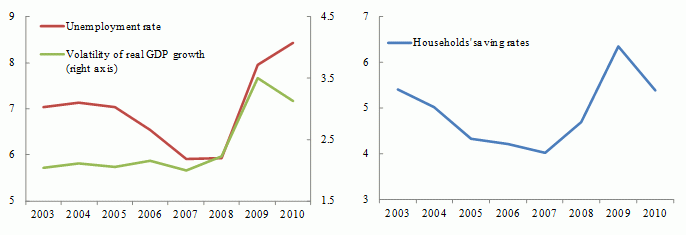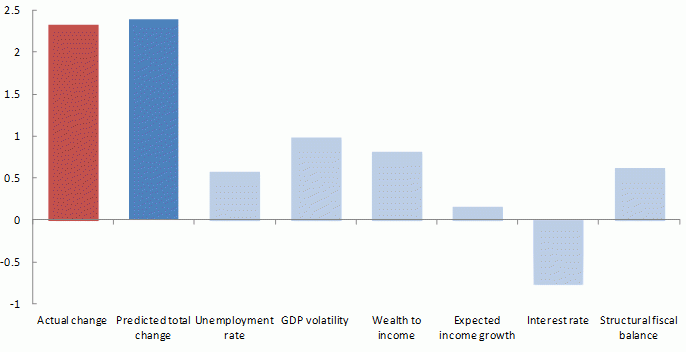A key feature of the Great Recession was a striking increase in uncertainty. The volatility of real GDP increased (left chart in Figure 1) and, at the same time, the higher unemployment rate raised the risks of job losses, longer unemployment durations, and, hence, of severe reductions in income (see Carroll 1992 for a similar interpretation of unemployment rates). These developments stood in marked contrast to the immediately preceding years of apparent tranquility, often characterised as the Great Moderation. The transition was marked by the initially innocuous subprime tremors in the US markets in mid-2007, which were followed in late 2008 and early 2009 by an existential threat to the global financial system. Meanwhile, private consumption growth dropped steeply and remains anaemic, mirroring, to a large extent, the rise in households’ saving rates between 2007 and 2009 (right chart in Figure 1).
Figure 1. Increase in labour-income uncertainty (left chart) and households saving rates (right chart) during the Great Recession (average over 14 OECD countries)
We test the proposition that some part of the observed rise in national household savings rates was the consequence of higher uncertainty. Households presumably reduced consumption to build buffers against further adverse shocks to their incomes. This was all the more so because the decline in financial and housing wealth needed to be restored. Such precautionary behaviour has often been documented at the micro level (for individuals and households), but only rarely for aggregate savings (Carroll 1992 is among the exceptions, but is limited to the US).1
To measure the strength of the relationship between savings and uncertainty, we estimate country fixed effects regressions on a panel of OECD countries between 1980 and 2011. Specifically, we regress households’ saving rates on measures of uncertainty and other standard determinants of savings that have been identified in the literature such as income growth, the interest rate, the wealth-to-income ratio, and the government structural balance, which captures Ricardian equivalence effects. In doing so, we follow the large consumption and saving literature and interpret our regressors as reasonable determinants of household saving rates.
Concerns about endogeneity cannot be dismissed. For example, there might be some reverse causality from savings to unemployment, in so far as an exogenous increase in saving reduces aggregate demand and labour demand. This concern is, at least, somewhat less important than in earlier analyses of saving rates, since the process of globalisation over the last two decades has reduced the dependence of domestic production on domestic demand and financing. Similarly, the endogeneity of the interest rate with respect to the domestic saving supply has weakened. We use the lag of the financial wealth ratio as a determinant of savings and control for omitted variables through country fixed effects as well as variables that capture the world economic cycle and thus absorb common variation across countries.
Our estimates reveal a highly significant positive partial correlation between the saving rate and our measures of labour-income uncertainty, the unemployment rate and the volatility of GDP growth. While other control variables included in the regression have the expected impact, of particular interest is the negative correlation between saving rates and the wealth-to-income ratio. This is often also interpreted as evidence of precautionary motives, since a reduction in wealth induces consumers to save more to re-accumulate an optimal amount of precautionary savings buffers. We find that stock-market volatility, which also increased substantially during the crisis, had no bearing on saving rates. This is consistent with the theoretical literature. While higher investment uncertainty stimulates precautionary savings, the risk of negative returns acts as a deterrent, so that the net effect is ambiguous and muted.2
These results are robust to controlling for global effects as well. We detect a negative correlation between saving rates and the copper-to-gold price ratio, which can be interpreted as a proxy for expected growth in world GDP (see Mody et al. 2012). Savings rates are positively correlated with the TED spread, which captures stress in the interbank market and thus a tightening of credit conditions.
Using our econometric estimates, we can infer the quantitative importance of precautionary motives in driving the sharp increase in household’s saving rates between 2007 and 2009. For the sample, the average increase in saving rates was 2.3 percentage points (Figure 2), which the econometric model predicts rather well. The increase in labour-income uncertainty, reflected in higher unemployment and GDP volatility, accounts for more than two-fifths of the overall increase in saving rates. Saving rates also increased considerably in response to the large wealth losses. If we consider that the reduction in asset prices may have itself been a consequence of higher volatility, uncertainty clearly played a major role in shaping consumers’ behaviour.
Figure 2. Actual and predicted increase in households' saving rates between 2007 and 2009 for 14 OECD countries
In contrast to the effects due to uncertainty, saving rates increased only mildly in response to lower expected income growth. Consumption growth was more materially propped up by lower real interest rates, which allowed consumption to be brought forward and, thereby, contain the increase in savings. Finally, higher fiscal deficits were associated with higher private savings rates (presumably through the Ricardian equivalence effect). Our estimates suggest that about one-fifth of the stimulus effect of the structural fiscal deficits was clawed back by higher private savings rates.
Policy considerations
Although the recession is formally over, at least in some countries, uncertainty persists. Thus greater income uncertainty and lower asset prices (themselves likely the reflection of higher perceived risk) could further constrain consumption growth. Restoring a healthy level of private demand will undoubtedly take time, as households gradually strengthen their balance sheets.
Our results suggest lower interest rates have been crucial to supporting domestic consumption demand and this is likely to remain important. Fiscal deficits to support aggregate demand work in a more complex manner. Their positive effect on consumption growth is partly offset by higher private savings. However, our estimates also imply that the composition of public expenditure matters. Private consumption can be increased significantly by reducing labour-income uncertainty. For this reason, even in these times of tight budgets, it is important to support employment-friendly social insurance schemes, especially in the more distressed economies that will have to confront substantial structural changes. Moreover, fiscal support for investment has both short-term and longer-term implications for GDP growth. A less tangible, but particularly important, requirement during this phase is for policymakers to reduce policy uncertainty and establish credibility by maintaining their support strategies for the recovery in a clear and consistent manner. At the time of writing, the signs in this regard are not propitious.
Authors’ note: The views expressed herein are those of the authors and should not be attributed to the IMF, its Executive Board, or its management.
References
Bloom, Nicholas (2009). “The Impact of Uncertainty Shocks”, Econometrica, Vol.77, No. 3, pp.623-685.
Bloom, Nicholas and Max Floetotto (2009). “The recession will be over sooner than you think”, VoxEU.org, 12 January.
Bloom, Nicholas, Max Floetotto, Nir Jaimovich, Itay Saporta-Eksten and Stephen Terry (2011). “Really Uncertain Business Cycles,” Working Paper.
Carroll, Christopher (1992). “The Buffer-Stock Theory of Saving: Some Macroeconomic Evidence,” Brookings Papers on Economic Activity, Vol. 1992, No.2, pp. 61-156.
Mody, Ashoka, Franziska Ohnsorge, and Damiano Sandri (2012). “Precautionary Savings in the Great Recession,” IMF Working Paper 12/42. Forthcoming in the IMF Economic Review.
1 A more extended discussion of the literature is in Mody et al. (2012).
2 Bloom and his coauthors’ analysis suggests that a spike in stock market volatility is followed by a sharp decline in GDP growth but these spikes tend to be short-lived and GDP growth can reaccelerate quickly once the initial shock is absorbed. In contrast, our measures of volatility suggest that the effects are more sustained.







